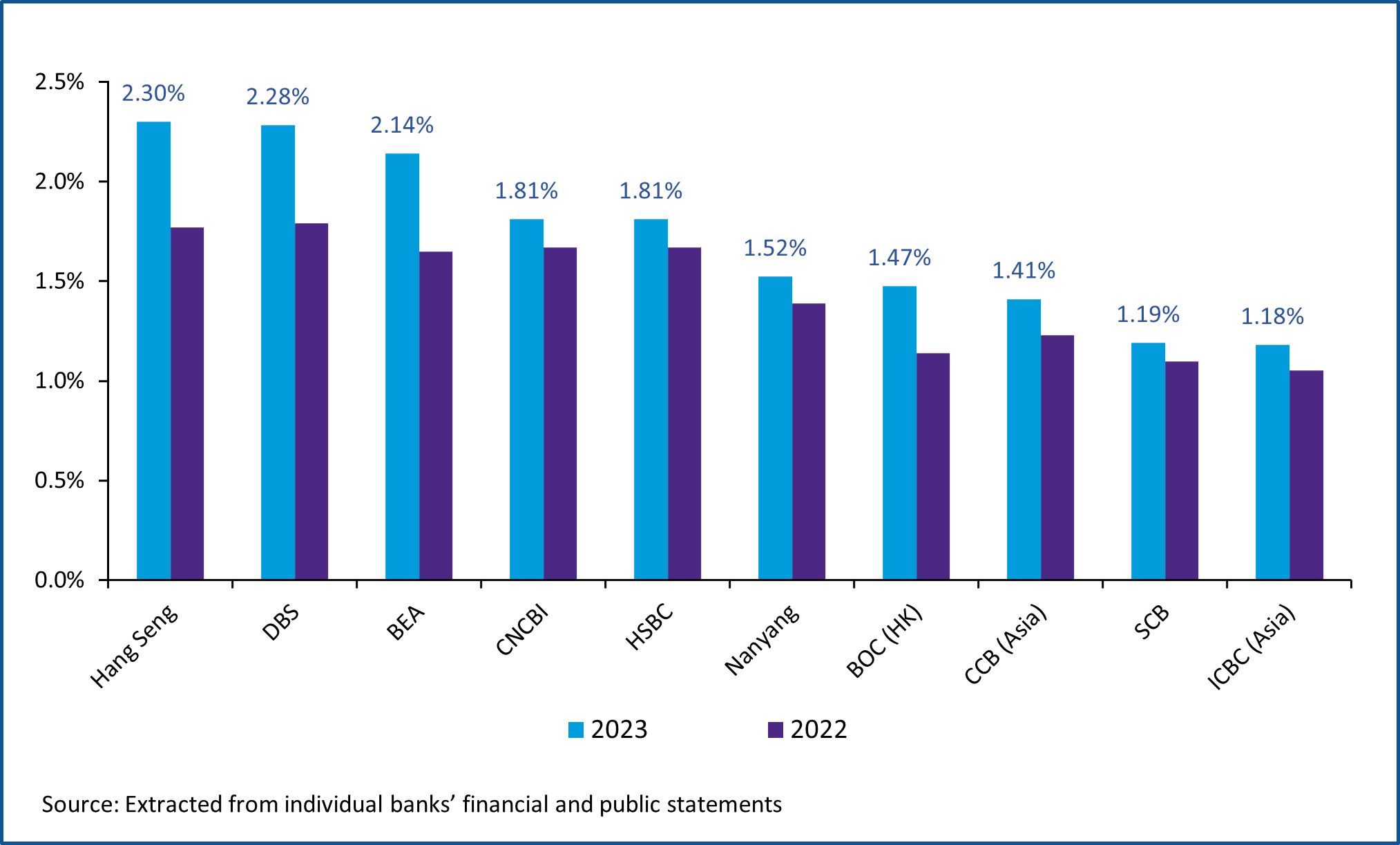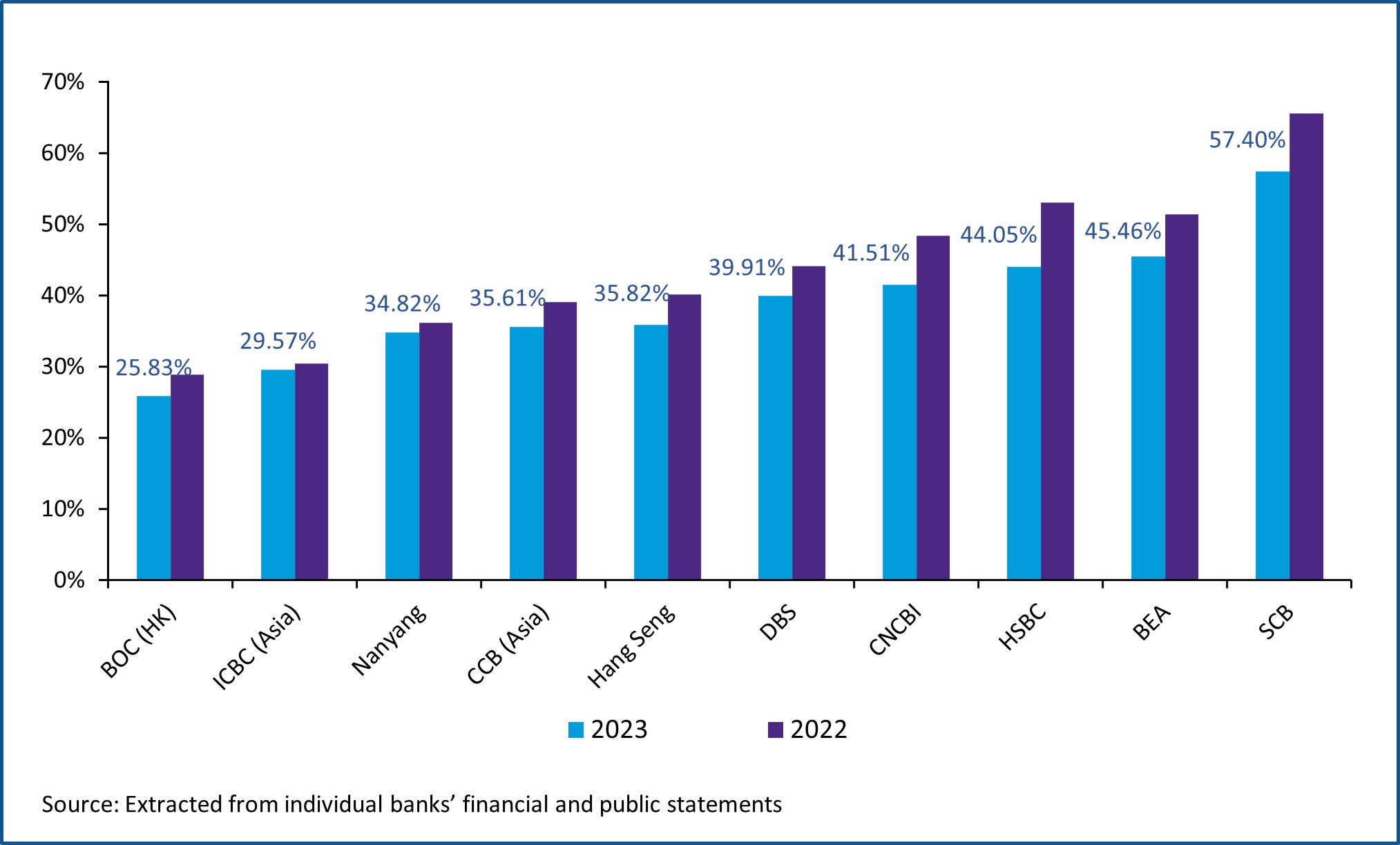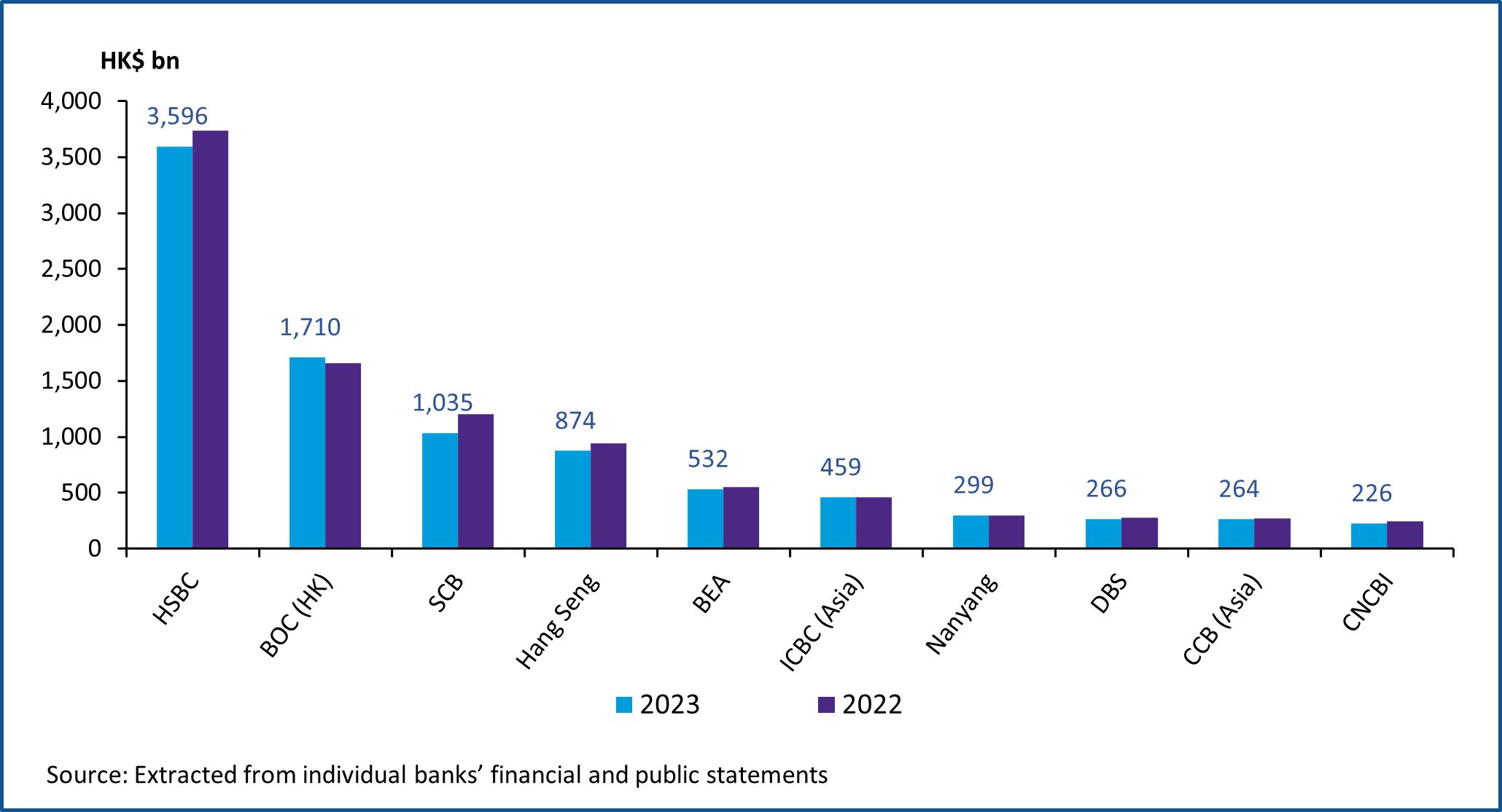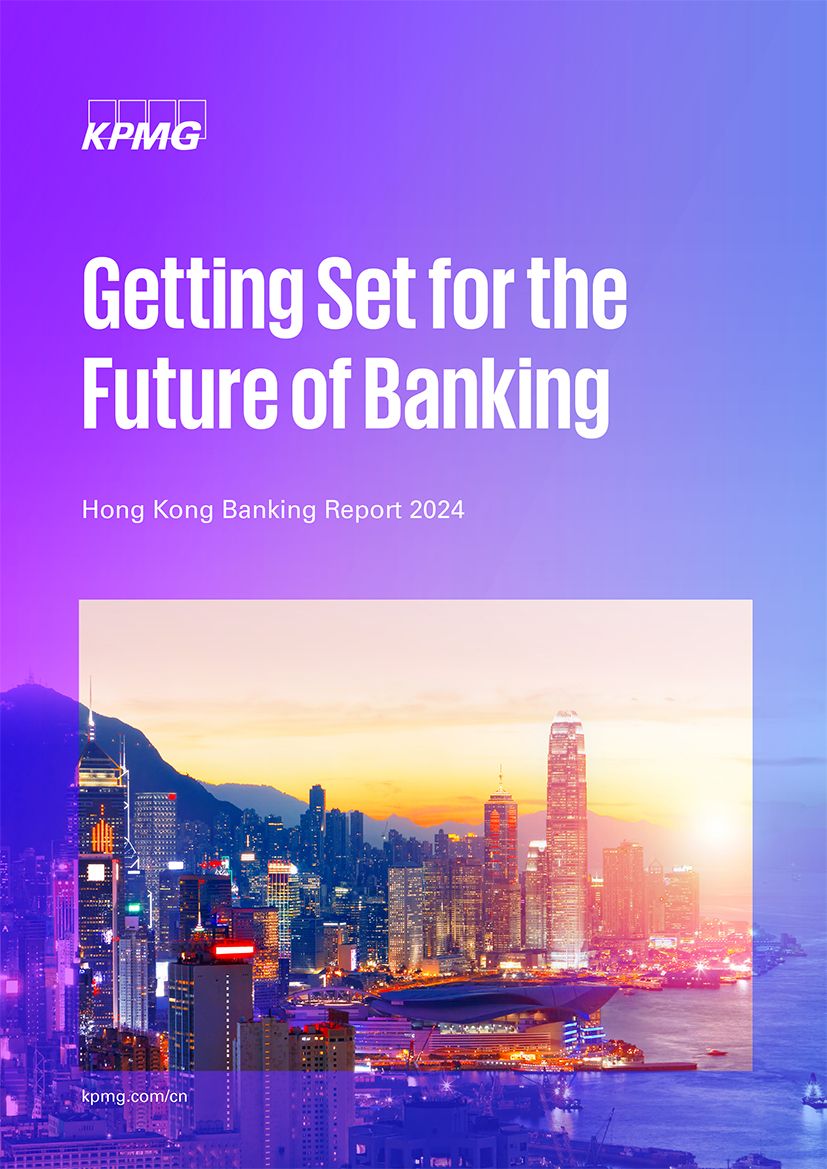Banks in Hong Kong saw moderate balance sheet growth in 2023 with notable increases in net interest margins and operating profit amid higher interest rates
The global economy showed resilience in 2023, highlighted by improved levels of growth despite a higher interest rate environment and heightened geopolitical tensions. Notwithstanding the challenges in the Mainland Chinese economy, the Hong Kong economy expanded by 3.2% in 20231 compared to a 3.5% contraction in 2022, driven by the gradual recovery of inbound tourism and improved private consumption expenditure.
Against this backdrop, Hong Kong’s banking sector recorded moderate growth in its overall balance sheet in 2023. The total assets of all licensed banks expanded by 2.7% to HK$23 trillion. There was a decrease of 3.1% in loans and advances while customer deposits increased by 3.5%. In line with our prediction in our 2023 Hong Kong Banking Report, the higher interest rate environment continued to benefit banks in improving profitability with a notable increase in net interest margins (NIM). The NIM for all licensed banks increased by 30 basis points in 2023 to 1.84%. Operating profit before impairment charges for all licensed banks increased by 34.7% to HK$295 billion in 2023.
The US Federal Reserve raised the Federal Funds Rate by a total of 100 basis points in 2023 and has maintained the rate at 5.5% since July 2023. Following the increase in Federal Funds Rate, the HKMA raised the base rate from 4.75% to 5.75%. This led to an increase in the Hong Kong Interbank Offered Rate (HIBOR) in 2023 from 4.35% in December 2022 to 5.27%2 (for one-month HIBOR) in July 2023. The composite interest rate, which is a measure of the average cost of funds of banks, increased by 83 basis points from 2.11% in December 2022 to 2.94% in December 20233.
The Hong Kong (SAR) Government forecasts that the Hong Kong economy will grow by 2.5 to 3.5% in 2024, after a 3.2% growth in 2023. The consumer price inflation is forecast to be 1.7% in 2024, similar to 2023. Looking ahead, while interest rate levels have somewhat stabilised, most expect interest rates to remain elevated and anticipate a gradual decrease, which will depend on decreasing US inflation. While this will continue to improve profitability, banks need to be vigilant in managing the credit risk in their loan portfolios as their customers may face difficulties from rising funding costs, potentially weakening their debt-servicing ability, and uncertainty in economic recovery both in Hong Kong and the Chinese Mainland.
The performance of the Hong Kong banking sector in 2024 will continue to be affected by uncertainties associated with US monetary policy, the global growth outlook and geopolitical tensions. It will also be closely linked with the health of the Chinese Mainland economy, which remains challenged by subdued consumer and business confidence and a weak real estate sector.
In this article, we present an analysis4 of key metrics for the top 10 locally incorporated licensed banks5 in Hong Kong. While some banks have a dual entity structure in Hong Kong (eg a branch and an incorporated authorised institution), we have not combined their results. The analysis is performed on a reporting entity basis.
Net interest margin
Net interest margin

The average NIM6 across all surveyed licensed banks increased by 30 basis points compared with 2022, which was driven by the higher interest rate environment with a relatively steeper yield curve on financial assets. The total net interest income of all surveyed licensed banks increased by 20.8% from HK$260 billion in 2022 to HK$314 billion in 2023. The average NIM for the top 10 licensed banks in 2023 increased to 1.65% from 1.41% in 2022. All the top 10 licensed banks recorded an increase in NIM.
Among the top 10 licensed banks, Hang Seng Bank, Limited (Hang Seng), DBS Bank (Hong Kong) Limited (DBS) and The Bank of East Asia, Limited (BEA) recorded the 3 largest NIM in 2023. Hang Seng also recorded the largest increase, of 53 basis points, from 1.77% in 2022 to 2.30% in 2023. The increase was largely driven by the 27 basis point increase in interest spread, attributable mainly to the bank’s proactive management of its assets and liabilities amid the rising interest rate environment7.
DBS’s NIM improved to 2.28% in 2023 from 1.79% in 2022. The net interest income increased by HK$2,464 million, or 29.8%, due to the higher interest rate.
The NIM of BEA increased by 49 basis points from 1.65% in 2022 to 2.14% in 2023. Net interest income increased by 24.9% from HK$13,508 million to HK$16,874 million. The increase was mainly attributed to higher interest rates and the 13.8% increase in investment securities, partly offset by the 3.1% decrease in customer loans8.
In our view, the higher interest environment will continue to benefit banks and improve NIM. However, subdued customer sentiment and elevated funding costs may also weigh on the profitability of banks as deposit spreads narrow and demand for loans remains low. Going forward, while interest rates are expected to stabilise or gradually decrease, the timing and pace are still subject to a host of uncertainties, so banks should plan their strategies accordingly.
Although interest rates have stabilised since July 2023, the higher interest rate environment continued to result in funds flowing out of current and savings account (CASA) balances as customers sought to maximise yield. CASA contributed 43% of total deposits as at the end of 2023 compared to 48% as at the end of 2022. This trend will likely continue as long as interest rates remain elevated.
Costs
Cost-to-income ratios

Cost control remained a critical priority for banks in Hong Kong to enhance profitability and this was reflected in the cost-to-income ratio for the surveyed banks, which on average decreased by 6.5 percentage points in 2023 to 42.6%. This was driven by a 19.6% increase in operating income and partly offset by a 3.8% increase in operating expenses, reflecting banks’ continued investments in technological innovation and digitalisation to improve efficiency. While talent retention and acquisition remained challenging for the banking industry in general, the total staff costs of the surveyed banks stayed broadly consistent with a slight increase of 3.2% in 2023.
The top 10 surveyed banks recorded a 20.6% increase in total operating income, combined with a 3.4% increase in total operating expenses. The weighted-average cost-to-income ratio of the top 10 banks improved notably from 46.94% in 2022 to 41.34% in 2023.
All the top 10 surveyed banks recorded a decrease in the cost-to-income ratio. Bank of China (Hong Kong) Limited (BoC (HK)) and Standard Chartered Bank (Hong Kong) Limited (SCB) recorded the lowest and highest cost-to-income ratios, respectively.
The Hongkong and Shanghai Banking Corporation Limited (HSBC) recorded the largest decrease in cost-to-income ratio among the top 10 banks from 53.06% in 2022 to 44.05% in 2023. The lower cost-to-income ratio was driven by a 18.7% increase in operating income due to the higher net income from financial instruments held for trading or managed on a fair value basis and higher net interest income, and partly offset by the 3.2% increase in operating expenses, which was mainly related to continuous investment in technology and people to support business growth9.
SCB recorded the second largest decrease in cost-to-income ratio from 65.55% in 2022 to 57.40% in 2023, although it remained the only bank with a cost-to-income ratio exceeding 50%. The reduced cost-to-income ratio was attributed to the 15.6% growth in operating income due to higher net trading income and net interest income, partly offset by a slight increase of 1.2% in operating expenses10.
Loans and advances
Loans

Total loans and advances of all surveyed banks decreased by 3.1% to HK$9,730 billion at the end of 2023 after a decrease of 0.6% in 2022, reflecting weaker loan demand in the elevated interest rate environment and banks’ prudent credit underwriting amid uncertain economic recovery. Commercial loans, mortgage lending and loans for use outside Hong Kong continued to make up most of the loan portfolios, representing 89.4% of total loans in 2023 compared with 89.5% in 2022. Loans for use outside Hong Kong and commercial loans continue to be the two largest types of loans. The balance remained relatively flat for all loan products.
HSBC and BOC (HK) continue to lead the lending market, constituting 54.5% of total loans of all surveyed banks as at 31 December 2023.
Among the top 10 surveyed banks, gross loans and advances further decreased by 3.6% to HK$8,387 billion, after the decrease of 0.8% in 2022. Eight out of the top 10 surveyed banks recorded a reduction in their loan portfolio.
SCB recorded the largest decrease in loan balances from HK$1,201 billion to HK$1,035 billion in 202311. The decrease was mainly driven by the contraction of property development lending, lending to financial companies, and trade finance.
BOC (HK) recorded the largest increase in loan portfolio by 3.2% to HK$1,710 billion, which was mainly driven by the growth in property development lending, manufacturing lending and residential mortgage loans12.
After three years of growth in its loan portfolio, DBS experienced loan contraction in 2023. The gross loans of DBS decreased by 4.9% from HK$280 billion in 2022 to HK$266 billion in 202313. The decrease was mainly due to the decrease in property development lending, transport and transport equipment lending and trade finance.
HSBC’s gross loans and advances, which cover its Asia Pacific operations, decreased by 3.7% to HK$3,596 billion14. The overall loan balances for HSBC’s Hong Kong operations remained stable with increase in residential mortgages, partly offset by decrease in corporate and commercial lending.
Credit quality
Impaired loan ratio

As the Chinese government continues to grapple with the lingering effects of Covid on the Chinese Mainland economy, the credit quality of the Hong Kong banking sector declined. Adding to the situation, the uncertain recovery of the local economy led to more defaults of SMEs in Hong Kong. The impaired loan ratio15 for all surveyed banks increased from 1.36% to 1.65% and the impaired loan ratio for the top 10 banks also increased from 1.33% to 1.62%.
For the top 10 surveyed banks, BOC (HK) and Hang Seng recorded the lowest and highest impaired loan ratio in 2023, respectively. BOC (HK) had the lowest impaired loan ratio of 1.04% in 2023, up from 0.53% in 2022. The impaired loan ratio of Hang Seng increased from 2.56% in 2022 to 2.83% in 2023, largely driven by the increase in impaired loans in relation to the property development and investment sector, predominately to the Chinese Mainland commercial real estate sector16.
The impaired loan ratio of Nanyang Commercial Bank, Limited (Nanyang) increased from 1.19% in 2022 to 2.32% in 2023, being the largest increase among the top 10 surveyed banks during 2023. The increase was mainly attributed to the increase in impaired loans in relation to the real estate sector in Hong Kong and the Chinese Mainland17.
DBS was the only bank that recorded an improving impaired loan ratio among the top 10 licensed banks, from 1.25% in 2022 to 1.11% in 2023. The reduction was mainly due to several write-offs of impaired loans in relation to manufacturing lending and the general commerce sector18.
In 2023, the challenges facing the Chinese Mainland real estate sector continued to escalate so the Chinese authorities introduced supportive policies in an attempt to stabilise the property market. For instance, the “Three No-Lowers” requirement was unveiled in November 2023 to encourage financial institutions to extend loans to property developers and house buyers to meet their reasonable financing needs. However, with China Evergrande being ordered to liquidate in Hong Kong and several other real estate developers experiencing severe stress, the path to recovery for the Chinese Mainland real estate sector remains uncertain for the foreseeable future. We expect that banks’ profitability could come under additional pressure as they manage exposures to this industry.
On the retail side, the Hong Kong (SAR) Government announced a relaxation of the demand-side management measures for residential properties in October 2023 and the cancellation of these measures in late February 2024. Following four increases in the HKMA Base Rate from 4.75% to 5.75% in 2023, several banks raised their Best Lending Rates in May and July 202319. Amid declining housing prices, particularly in residential properties, the aggregate value of residential mortgage loans in negative equity increased to HK$131,297 million in December 202320 compared with HK$66,252 million in December 202221. The cases were mainly related to bank staff housing loans or residential mortgage loan under the Mortgage Insurance Programme, which generally have a higher loan-to-value ratio. However, the overall mortgage delinquency ratio remained low at 0.08% in 202322 and the risks relating to banks’ residential mortgage loans does not appear to be significant.
Going forward, the key focus for the credit quality outlook will be the exposures to the Chinese Mainland real estate sector and Hong Kong’s SMEs. Any further measures taken by the Chinese Mainland authorities to contain and manage the issues arising from the real estate sector will be crucial in stabilising the market and limiting defaults among borrowers. Separately, the pace and strength of Hong Kong’s economic recovery from the lingering impacts of Covid will be another key factor, as a robust rebound in Hong Kong’s economy will contribute to improved credit conditions, especially for SMEs. Banks should continue to closely monitor the developments in these two crucial areas and track the performance and asset quality of their loan portfolios.
[1] 2023 Economic Background and 2024 Prospects, Hong Kong SAR Government, February 2024, p.2, 19 https://www.hkeconomy.gov.hk/en/pdf/er_23q4.pdf
[2] The Hong Kong Association of Banks - HKD Interest Settlement Rates Highlights
[3] Composite Interest Rate: End of December 2023
https://www.hkma.gov.hk/eng/news-and-media/press-releases/2024/01/20240118-3/
[4] The analysis is based on financial institutions registered with the Hong Kong Monetary Authority.
[5] The top 10 locally incorporated licensed banks mentioned in this article are the 10 banks with highest total assets among all locally incorporated licensed banks as at 31 December 2023.
[6] NIM is either quoted from public announcements of financial statements, or calculated based on annualised net interest income and interest-bearing assets or total assets, depending on the availability of information.
[7] Hang Seng Annual Report 2023, p.31
https://vpr.hkma.gov.hk/statics/assets/doc/100057/ar_23/ar_23_eng.pdf
[8] BEA Annual Report 2023, p.190
https://vpr.hkma.gov.hk/statics/assets/doc/100013/ar_23/ar_23.pdf
[9] HSBC Annual Report 2023, p.20, 21 https://vpr.hkma.gov.hk/statics/assets/doc/100002/ar_23/ar_23_eng.pdf
[10] SCB Annual Report 2023, p.12 https://vpr.hkma.gov.hk/statics/assets/doc/100269/ar_23/ar_23_eng.pdf
[11] SCB Annual Report 2023, p.50 https://vpr.hkma.gov.hk/statics/assets/doc/100269/ar_23/ar_23_eng.pdf
[12] BOC (HK) Annual Report 2023, p.163 https://vpr.hkma.gov.hk/statics/assets/doc/100072/fd_fin/fd_fin_1223.pdf
[13] DBS Annual Report 2023, p.28 https://vpr.hkma.gov.hk/statics/assets/doc/100034/ar_23/ar_23_eng.pdf
[14] HSBC Annual Report and Accounts 2023, p.116 https://vpr.hkma.gov.hk/statics/assets/doc/100002/ar_23/ar_23_eng.pdf
[15] Impaired loan ratio is calculated as impaired loans and advances divided by gross loans and advances to customers.
[16] Hang Seng Annual Report 2023, p.33 https://vpr.hkma.gov.hk/statics/assets/doc/100057/ar_23/ar_23_eng.pdf
[17] Nanyang 2023 Regulatory Disclosure Statement, p.38 https://vpr.hkma.gov.hk/statics/assets/doc/100060/fd_int/fd_int_1223_eng.pdf
[18] DBS Annual Report 2023, p.43 https://vpr.hkma.gov.hk/statics/assets/doc/100034/ar_23/ar_23_eng.pdf
[19] Half-yearly Monetary and Financial Stability Report, September 2023, p.5 https://www.hkma.gov.hk/media/eng/publication-and-research/quarterly-bulletin/qb202309/E_Half-yearly_202309.pdf
[20] Residential mortgage loans in negative equity: End of December 2023
https://www.hkma.gov.hk/eng/news-and-media/press-releases/2024/01/20240131-6/
[21] Residential mortgage loans in negative equity: End of December 2022
https://www.hkma.gov.hk/eng/news-and-media/press-releases/2023/01/20230131-8/
[22] Residential Mortgage Survey Results for December 2023
https://www.hkma.gov.hk/eng/news-and-media/press-releases/2024/01/20240131-5/
Financial Results
Compare the results of banks across a variety of metrics in the charts for each of the five categories of banks in Hong Kong
Performance Rankings | Licensed banks | Virtual banks | Restricted licence banks | Deposit taking companies | Foreign bank branches

Hong Kong Banking Report 2024
Report on the 2023 financial performance of banks in Hong Kong
Download PDF (4.4 MB) ⤓
Connect with us
- Find office locations kpmg.findOfficeLocations
- kpmg.emailUs
- Social media @ KPMG kpmg.socialMedia



